You’re going to the range this weekend to practice, right? You totally are, because I just know you wouldn’t procrastinate. So, when you do go, consider adding some fun and useful drills to spice it up. Not only can they be entertaining, but they can help you recognize flaws in your technique and hone your skills. Of course, don’t forget safety when trying out these drills.
Drawstroke and Speed: The Bill Drill

Designed by gun maker Bill Wilson, the Bill Drill is designed to improve your speed while keeping accuracy intact. You’ll learn how to recover from recoil, properly (and consistently) grip, utilize your sights better, stay relaxed while shooting, and improve your draw technique. And really, it all starts with the draw.
To do this, you will need to set up a target. An IPSC target is traditional for this drill, but you could technically do it with any target with clearly outlined zones. Stand at the seven-yard line and have your handgun holstered. Your hands will be at surrender position before drawing and hitting the target six times as quickly as possible. Now, we say as quickly as you can, but the accuracy needs to come before the speed.
Don’t just mag dump without thinking to try and hit the target six times. It all starts with your grip and draw stroke, so it really is worth practicing your draw with an unloaded firearm prior to this drill. Dry fire definitely has a place in training, plus it’s cheap. The goal is to not have to adjust your grip mid-drill. It’s important to learn to stay consistent. However, if you feel you need to adjust, do so and observe what changed and try again. This is about improving skills, so be honest with yourself.
Another major part of why this drill can be so challenging is following your sights. It’s not uncommon for shooters to hesitate between shots as they aim. In the Bill Drill, once your sight drops back from the previous recoil it’s time to quickly recognize where your sights are and shoot again. It helps reduce hesitancy and makes you more confident in your shot. It’s all about maintaining a good sight picture and rapid target acquisition throughout the string of fire.
If your body doesn’t stay relaxed when you shoot, there will be an even bigger learning curve. Many may feel that tensing up will help their speed but, the opposite tends to be true. If your body is tense during the entire drill your aim will likely fail and you may hesitate more. This once again is a great reason to incorporate dry fire into your training time.
Though the standard distance is seven yards, you can always start out at three and then five yards for slightly different skill goals and times. These can look like:
Seven yards: This incorporates all needed skills evenly as this is the standard distance. About two seconds is a rather commonly stated goal at this distance, but under four seconds tends to be a more workable goal at first. If you’re hitting the intended zone of your target, you’re on the right track. And really, the only person you’re competing against is yourself, so work on improving your times bit by bit.
Five yards: This is a great range to work on grip to see what works best. Aim is not going to make or break how many times you hit the target at this distance, but it is still a factor, as is recoil.
Three yards: Stay relaxed. Don’t get cocky just because you’re close. In fact, the closer you are, the tighter your resulting group should be. Don’t get sloppy.
What a Showoff: The Playing Card Drill

The Playing Card drill is a great opportunity if you’re looking for a fun way to evaluate your skills and potentially improve them. All you need is a berm, a deck of cards, and good aim. The overall goal is to get a 3 to 5-shot grouping on the card…in one ragged hole. You can do this by aiming at the suit in the center of the cards as your target or choosing a random spot on the playing card. Shooter’s choice.
Many people shoot at 3 yards for three shots, and 5 yards for five shots. However, you can technically adjust it as you’d like. This may seem easy at those distances but it can be a real challenge. If you have bad habits like poor sight alignment, sloppy follow-through, or iffy trigger control then this drill can help you work on them (and also expose them).
Overall, this drill takes focus, patience, and true marksmanship. When you’re done and have a good grouping, you have the perfect trophy for the fridge or a social media post. If anyone knows this drill, they’ll know how impressive a perfect group can be. Regarding timing, some people do this drill with a shot timer while others run it untimed. It really is your choice.
Know Your Basics: 5×5
The 5×5 (or 5^5) drill is a true test of your foundational skills. If you do well, it’s a good reassurance that you have your basics covered, and a sign that pursuing intermediate to advanced drills may be a good idea. If you struggle with this drill, it can help you realize where improvement is needed. Remember, as nice as it is to see perfect drills, it’s also good to find out where you need to improve.
It’s simple: starting from a low-ready position, stand 5 yards from your target and fire 5 rounds within 5 seconds. Simple, right? The target usually has a five-inch diameter circle, but not always. The overall goal is to make all shots within the said circle.
If you want an added challenge, draw from the holster or try it four times in a row (passing would be 25 shots without missing).
All of the Above: F.A.S.T

It can be tough to prepare yourself to shoot under stress, but the F.A.S.T drill is one that will definitely help you out. (F.A.S.T stands for Fundamental Accuracy and Speed Test.) This one was created by the late Todd Green who was basically the king of AIWB (appendix inside waistband) carry.
To do this drill, you’ll either need the original target (though it requires an 11×14 target which is harder to print yourself, although you can also order them online) or:
- Paper plate (the ‘chest’)
- 3” x 5” index card (the ‘head’)
The index card will need to be attached above the plate to simulate the real target.
At seven yards the shooter will have two rounds loaded. And yes, you’ll need spare mags on hand. Draw from concealment and shoot the two rounds into the index card. After that, the shooter will need to reload and then shoot four rounds into the “chest”.
This entire test should take 5-10 seconds, give or take, with five seconds being the ‘expert’ level, seven seconds as advanced, 10 as intermediate, and over 10 as beginner. However, your grade isn’t just the literal time. If you miss the index card, you add two seconds to your final time. If you miss the plate, add one second to your final time. You can see how easy it is to mess this one up. And remember, it has to be shot from concealment. No open carry or low ready.
If you do shoot from an open carry holster instead of concealed, add a half-second to your final time. If you use flattop holsters/ magazine pouches, subtract half a second. (Todd put a lot of thought into this.)
This drill tests almost every aspect of shooting to test your full competency including reloading. Rapid, smooth reloads really do take practice, and they’re important to master. As per usual, however, draw and accuracy are major points.
Don’t Flinch: The Coin/Brass Drill

This drill is super simple and great for beginners. To do this drill you need an unloaded gun and a penny (or, alternatively, you can use spent brass). Rest the penny on your front sight so it’s balanced. Your goal is to aim and pull the trigger without letting the penny fall. This can be a great way to weed out flinching in beginners and help commit to squeezing the trigger properly. Trigger control is vital to hone, and you’ll find the further you are from a target during live fire, the more trigger control problems will become clear. Say it with us: dry fire is your friend.


